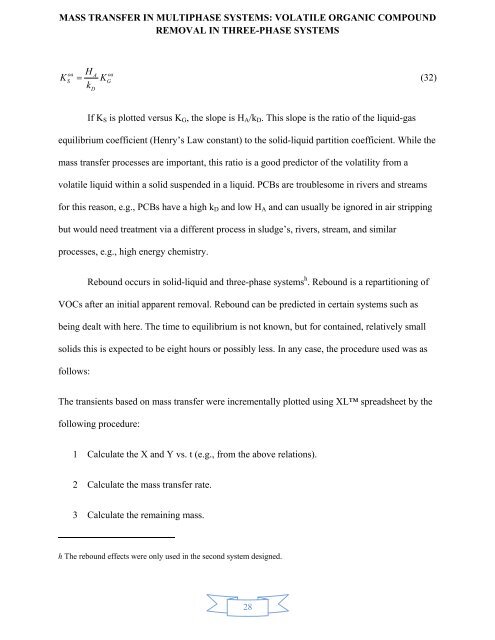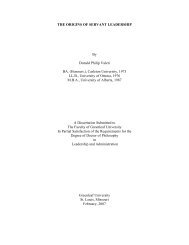mass transfer in multiphase systems - Greenleaf University
mass transfer in multiphase systems - Greenleaf University
mass transfer in multiphase systems - Greenleaf University
You also want an ePaper? Increase the reach of your titles
YUMPU automatically turns print PDFs into web optimized ePapers that Google loves.
MASS TRANSFER IN MULTIPHASE SYSTEMS: VOLATILE ORGANIC COMPOUND<br />
REMOVAL IN THREE-PHASE SYSTEMS<br />
K<br />
oa<br />
S<br />
H<br />
A oa<br />
KG<br />
(32)<br />
kD<br />
If K S is plotted versus K G , the slope is H A /k D . This slope is the ratio of the liquid-gas<br />
equilibrium coefficient (Henry’s Law constant) to the solid-liquid partition coefficient. While the<br />
<strong>mass</strong> <strong>transfer</strong> processes are important, this ratio is a good predictor of the volatility from a<br />
volatile liquid with<strong>in</strong> a solid suspended <strong>in</strong> a liquid. PCBs are troublesome <strong>in</strong> rivers and streams<br />
for this reason, e.g., PCBs have a high k D and low H A and can usually be ignored <strong>in</strong> air stripp<strong>in</strong>g<br />
but would need treatment via a different process <strong>in</strong> sludge’s, rivers, stream, and similar<br />
processes, e.g., high energy chemistry.<br />
Rebound occurs <strong>in</strong> solid-liquid and three-phase <strong>systems</strong> h . Rebound is a repartition<strong>in</strong>g of<br />
VOCs after an <strong>in</strong>itial apparent removal. Rebound can be predicted <strong>in</strong> certa<strong>in</strong> <strong>systems</strong> such as<br />
be<strong>in</strong>g dealt with here. The time to equilibrium is not known, but for conta<strong>in</strong>ed, relatively small<br />
solids this is expected to be eight hours or possibly less. In any case, the procedure used was as<br />
follows:<br />
The transients based on <strong>mass</strong> <strong>transfer</strong> were <strong>in</strong>crementally plotted us<strong>in</strong>g XL spreadsheet by the<br />
follow<strong>in</strong>g procedure:<br />
1 Calculate the X and Y vs. t (e.g., from the above relations).<br />
2 Calculate the <strong>mass</strong> <strong>transfer</strong> rate.<br />
3 Calculate the rema<strong>in</strong><strong>in</strong>g <strong>mass</strong>.<br />
h The rebound effects were only used <strong>in</strong> the second system designed.<br />
28



